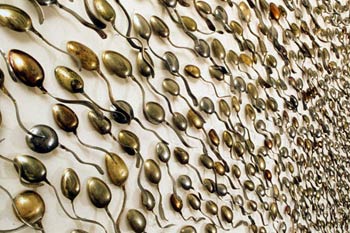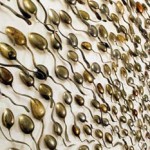By CHRISTIAN HOLLAND
In Merging Influence: Eastern Elements in New America Art, the word "east" has a somewhat dubious meaning. It does not necessarily mean the “Far East,” but means what is not the West. The idea brings about a colonialist sense of the world, as it generalizes the scope of the show and narrows its point of reference. It is also difficult to discern what is meant by the phrase “New American Art.” The artists all live in the United States, so they are “American." They are all contemporary artists, so their work is “new.” However, does the show mean “New American?” in the same sense that the Boston press labeled Sam Yoon, the city’s first Asian elected official, part of “New Boston” during his first run for city councilor? Either way you consider it, there is an implied division of Americans, and this is the crux of the show.
Touching on globalism, the show succeeds in its discussion of the mixed heritage of the individual artists, but it foregrounds the foreignness of the artists and so exoticizes them. The show “presents artists who... create art that uses forms, methods, or concepts that are inspired by their various cultural origins from outside of the U.S.” Not helping the apparent lackadaisical scholarship is an error in the first paragraph regarding the birthplaces of the two Chinese artists in the show. The essay states that Yun-Fei Ji is from mainland China and C. Meng is from the Chinese province of Shanghai. Well, Shanghai is in fact in mainland China though, it has “province-level status,” and is a municipality or city.
There are indeed many types of Americans; as far as nation-states are concerned, the USA is more cosmopolitan than not, despite its homogenous heartland. From the first paragraph of Assistant Gallery Director and the exhibit’s curator Shana Dumont’s essay on the show “Their Artwork exemplifies the ways that art can link to visual history at a time when globalism is a prevalent cultural force.” Much of the work in the show could have been created anywhere in the world, it just bears an “ethnic” component.
If you want to talk about international aspects in New American art, why the east? The selection just seems arbitrary. There are literally thousands of artists in the U.S. that draw upon their cultural heritage. The show is indicative of the issue that we have not found a way to define art in the age of globalism; the ghosts of colonialism still haunt our galleries.
- Eung Ho Park, Sperm Spoons, spoons & adhesive, 2007
- Shelly Bahl, Pink is the Navy Blue of India, film still, 2003
"Merging Influence: Eastern Elements in New American Art" is on view through October 27 at the Montserrat Gallery.
All images are courtesy of the artists and Montserrat College of Art.





